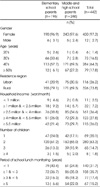1. Bellisle F. Effects of diet on behaviour and cognition in children. Br J Nutr. 2004; 92:Suppl 2. S227–S232.
2. Kim SA, Lee BH. Relationships between the nutrient intake status, dietary habits, academic stress and academic achievement in the elementary school children in Bucheon-si. Korean J Nutr. 2008; 41(8):786–796.
5. MacLellan D, Holland A, Taylor J, McKenna M, Hernarndez K. Implementing school nutrition policy: student and parent perspectives. Can J Diet Pract Res. 2010; 71(4):172–177.
6. Ministry of Education and Human Resources, Korean Educational Development Institute. Guide of school lunch programs monitoring parents. Korean Educational Development Institute;2017. 03. Report No. CRM 2017-12.
7. Kim MH, Yoon KO. The survey of materials receiving and monitoring of parents in primary school food service. Korean J Community Living Sci. 2007; 18(2):313–321.
8. Lee SI, Kang PY, Jung HY. Parents' perception and satisfaction of school food materials and supplier: performance in Mokpo, Korea. J Korean Soc Food Sci Nutr. 2015; 44(11):1741–1749.
9. Baek M, Lee YM, Oh YJ. A study on parents' satisfaction with school foodservice by foodservice monitoring participation. J Korean Diet Assoc. 2009; 15(3):253–261.
10. Kim JE. A study on how the catering service menus made with local food effects of consumer's satisfaction: focused on university students in Jeonju. Korean J Tourism Res. 2014; 29(5):337–355.
11. Cho JH. Effects of service quality on customer's perceived value, customer satisfaction, trust, and behavioral intention in the university cafeteria. J Korea Serv Manage Soc. 2015; 16(5):73–100.
12. Cho HJ. The effects of transactional characteristics on conflict and financial performance between franchisor and franchisee. J Foodserv Manage. 2006; 9(2):189–210.
13. Kim WS, Han HS. Determinants of restaurant customers' loyalty intentions: a mediating effect of relationship quality. J Qual Assur Hosp Tour. 2008; 9(3):219–239.
14. Hynn SS. Predictors of relationship quality and loyalty in the chain restaurant industry. Cornell Hosp Q. 2010; 51(2):251–267.
15. Kim JS, Choi SH. A study on the effects of brand individuality of specialty coffee shops on brand loyalty. Culin Sci Hosp Res. 2011; 17(1):124–141.
16. Bowden-Everson JLJ, Dagger TS, Elliott G. Engaging customers for loyalty in the restaurant industry: the role of satisfaction, trust, and delight. J Foodserv Bus Res. 2013; 16(1):52–75.
17. Lee CH, Yi YJ. Development and application of the publicservice customer satisfaction index (PCSI) model. J Korean Mark Assoc. 2012; 27(4):60–99.
18. Bae HJ, Bae HJ. Survey on the performance practices and the opinions on school foodservice monitoring by dietitians and students' parents in Ulsan area. J Korean Soc Food Sci Nutr. 2009; 38(7):862–869.
19. Bae YM, Song DH, Ahn HS. Perceptions of traditional Korean foods and satisfaction levels toward school foodservice among middle school students and parents of schools serving traditional Korean menus in Gyeonggi province. J Korean Diet Assoc. 2011; 17(2):118–129.






 PDF
PDF ePub
ePub Citation
Citation Print
Print










 XML Download
XML Download